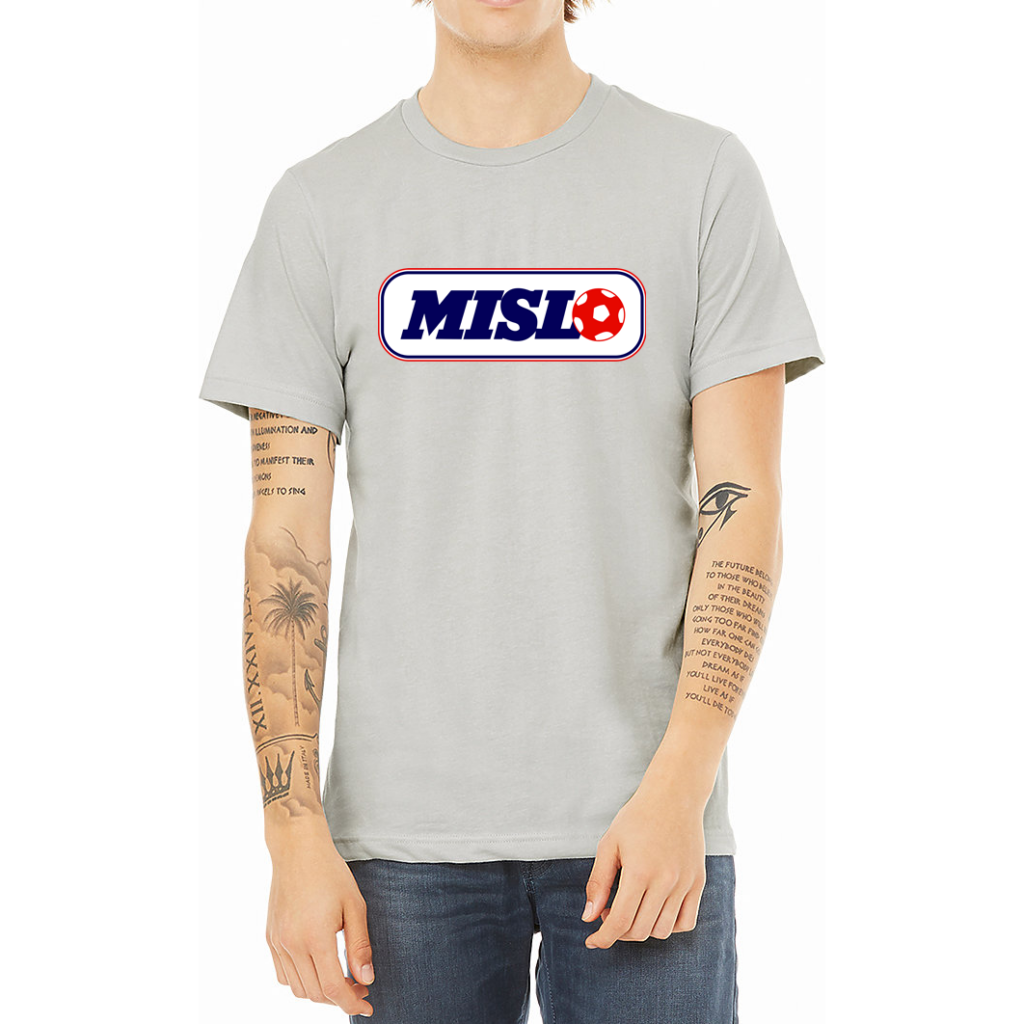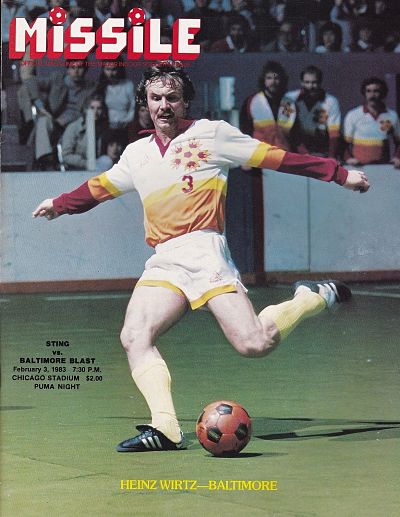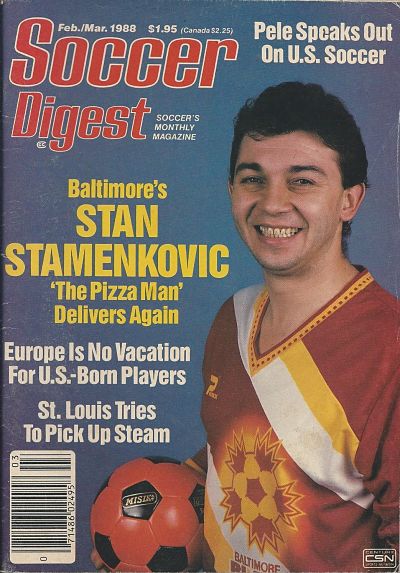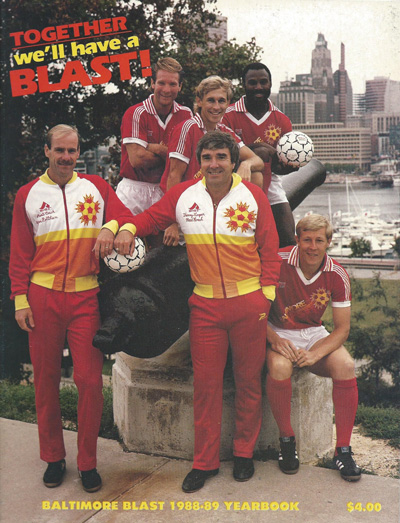Major Indoor Soccer League (1980-1992)
Tombstone
Born: May 1980 – The Houston Summit relocates to Baltimore, MD
Folded: July 1992
First Game: November 14, 1980 (L 4-3 @ Hartford Hellions)
Last Game: April 18, 1992 (L 4-3 vs. San Diego Sockers)
MISL Champions: 1984
Arena
Baltimore Arena (12,453)11984-85 Major Indoor Soccer League Media Guide
Opened: 1962
Marketing
Team Colors: Flaming Red-Orange & Fiery Yellow21984-85 Major Indoor Soccer League Media Guide
Television:
- 1984-85: WJZ-TV (13 – ABC Affiliate)
Television Broadcasters:
- 1984-85: Lou Tilley & Chris O’Donoghue
Radio:
- 1984-85: WFBR-AM (1300)
- 1990 -1992: WCAO-AM (600)
Radio Broadcasters:
- 1984-85: Art Sinclair (Play-by-Play) & Charlie Eckman (Color)
- 1990-91: Art Sinclair & Bob Bartel (Color)
- 1991-92: Dave Johnson (Play-by-Play) & Bob Bartel
Ownership
Owners:
- 1980-1984: Bernie Rodin
- 1984-1989: Nathan Scherr, Howard Perlow, Stuart Weitzman, et al.
- 1989-1992: Ed Hale
Sale (1984):$2.7 million + $400,000 for debt service3Glauber, Bill. “Scherr says he’d sell Blast share”. The Sun (Baltimore, MD). April 3, 1987
Sale (1989): $700,0004Boone, Eunetta. “Hale to buy Blast, keep team here”. The Evening Sun (Baltimore, MD). September 14, 1989
Attendance
Tilting your mobile device may offer better viewing.
Sources:
- Various Baltimore Blast and MISL media guides (1980-1991 figures)
- 2003-04 Dallas Sidekicks media guide (1991-92 figures)
Trophy Case
MISL Most Valuable Player
- 1983-84: Stan Stamenkovic
MISL Goalkeeper of the Year
- 1984-85: Scott Manning
- 1985-86: Keith Van Eron
Our Favorite Stuff
MISL Logo T-shirt
The Major Indoor Soccer League (MISL) kicked off in 1978 with six teams. At its peak, it boasted 14 teams with many drawing sell-out crowds. Remember the MISL in the great logo T-shirt from Royal Retros. Available in white and navy blue too!
Background
The original Baltimore Blast were a popular, immensely entertaining entry on the Baltimore sports scene throughout the 1980’s. The team arrived in Charm City in the spring of 1980 by way of Houston, Texas, where the franchise had failed to develop a following during the first two seasons of the Major Indoor Soccer League. But in Baltimore, the Blast would find a rare and enviable situation – a “Major League” sports market with a distinct shortage of Major League teams. Once the NFL’s Baltimore Colts snuck out of town on March 28th, 1984, the Blast had Baltimore’s winter sports scene all to themselves.
Civic Center Spectacle
Blast games at the Baltimore Civic Center were a spectacle, starting with the team’s elaborate pre-game introductions. The lights dimmed, Christopher Cross’ “Ride Like The Wind” boomed over the sound system and fog swirled. The Blast cheerleaders and players charged onto the arena floor from an exploding soccer ball-shaped spaceship that descended from the ceiling. Kool & The Gang’s “Celebration” was the Blast’s goal song and would be heard over and over again, as the high-scoring MISL averaged nearly 11 goals per match.
Rivalries
Beyond the marketing glitz, the Blast were a consistently terrific team under Head Coach Kenny Cooper. The Englishman moved with the franchise from Houston and guided the club for all 12 seasons in Baltimore. The Blast had fierce divisional rivalries with the New York Arrows in the early part of the 1980’s and then with the Cleveland Force in the middle of the decade.
But the team’s toughest opponent was Ron Newman’s San Diego Sockers, the great indoor dynasty of the 80’s. The Blast made the MISL playoffs eleven times in twelve seasons. On five occasions (’83, ’84, ’85, ’89 and ’90) the Blast advanced to the Championship Series, losing to Newman’s club four times. Baltimore’s only MISL title came in 1984, a season when the Sockers competed in the rival North American Soccer League.
1984 MISL Championship Season
On June 8th, 1984, the Blast defeated the St. Louis Steamers in Game 5 of the MISL finals to win the league championship. This win would mark the peak of the team’s popularity and influence in Baltimore. The Colts had just left town. The Blast averaged a franchise record 11,189 fans per game at the Civic Center in 1983-84. The victory was also a vindication of one of Kenny Cooper’s boldest moves. Eleven months earlier, Cooper paid a league record $150,000 transfer fee to purchase an overweight Yugoslav striker named Stan Stamenkovic from the Memphis Americans. Stamenkovic was known as “The Pizza Man” for his abominable dietary and conditioning habits. He led the MISL in scoring in both the regular season and playoffs and was the named the league’s Most Valuable Player for 1984.
The Blast’s 1984 championship was sweet for original owner Bernie Rodin. He was last man standing among the MISL’s original owners from 1978 and the series marked his final involvement with the league. Rodin sold the Blast for a league record $2.9 million to Nathan Scherr three months earlier. The ownership transfer took formal effect one week after the Blast’s finals victory.
Demise & Revival
The Blast continued to be a fixture in Baltimore for the rest of the decade, averaging over 10,000 fans per game through 1986. The fortunes of both the MISL and the Blast began to flag as the decade drew to an end. The league nearly folded in the summer of 1988. Budget cuts saw the Blast’s vaunted pre-game pyrotechnics scaled back in the late 1980’s, even as previously conservative NBA and NHL teams began to co-opt the MISL’s flashy game presentation tactics. Nathan Scherr’s early 1989 sale of the Blast to Ed Hale brought just $700,000, or less than 25% of what the team commanded five years earlier.
The Blast played their final matches in April 1992. Appropriately, the team lost their last contests to Ron Newman and the San Diego Sockers in the 1992 playoff semi-finals. Fewer than 5,000 fans turned out for each of the semi-final games at Baltimore Arena.
The MISL went out of business in July 1992 and the Blast closed up shop along with the league. Within a matter of days, a new indoor club called the Baltimore Spirit was organized with Kenny Cooper returning as Head Coach and Bill Stealey as the new owner. The Spirit entered the lower-budget National Professional Soccer League, where they would compete for six seasons. In 1998, former Blast owner Ed Hale purchased the Spirit from Bill Stealey and changed the name back to the Baltimore Blast. This second version of the Blast continues to play today under Ed Hale’s ownership.
Baltimore Blast Video
Blast host the Sockers in Game 6 of the 1990 MISL Championship Series. Prime Ticket cable network.
In Memoriam
Blast defender Mike Reynolds passed away at age 27 on July 1, 1991, two days after suffering a stroke at a Blast promotional event.
Polish defender Helmut Dudek (Blast ’87-’88) died at age 36 after a battle with cancer on May 22, 1994.
Former MISL MVP Stan Stamenkovic (Blast ’83-’88) died from a slip-and-fall in Serbia on January 28, 1996. He was 39.
English forward Paul Crossley (Blast ’80-’83) died from a heart attack at the age of 47 on March 11, 1996.
Former Blast owner Nathan Scherr (’84-’88) died of Parkinson’s disease on November 21, 2003 at age 80. Baltimore Sun obit.
Canadian striker Domenic Mobilio (’89-’92) died of a heart attack on November 13, 2004 at the age of 35.
Paul Kitson (’83-’86) suffered a fatal brain aneurysm while conducting a soccer clinic on August 25, 2005. Kitson was 49. Baltimore Sun obituary.
Goalkeeper Slobo Ilijevski (’88-’89) passed away July 14, 2008 at age 58 after suffering a ruptured aorta during a soccer game.
Midfielder Stan Koziol (’89-’90) died of leukemia on March 3, 2014 at age 48. Concacaf.com obituary.
Billy Ronson (’86-’92) passed away of undisclosed causes on April 8, 2015. Ronson was 58.
Downloads
11-13-1986 Blast vs. Cleveland Force Game Notes
11-13-1986 Baltimore Blast vs Cleveland Force Game Notes
2-14-1986 Blast vs. J.O.I.N.T. Program Press Release
2-3-1987 Blast vs. Dynamo Moscow Game Program
3-31-1988 Blast vs. St. Louis Steamers Game Notes
###






2 Responses
Thank you for the wonderful reminder of the joy and fun that I had with naming the Team, helping start the original booster club and selling about 5,000 tickets to games. Great Lads .. Great Team … Lotta Love
This article is incomplete without showing the TV commercial from 1998 that showed a soccer match being played in a Victorian style house; knocking over vases, kicking the ball through windows, smashing mirrors, generally trashing the place…. at the end of the spot an announcer read the message that appeared on the screen: “Indoor soccer is back!”